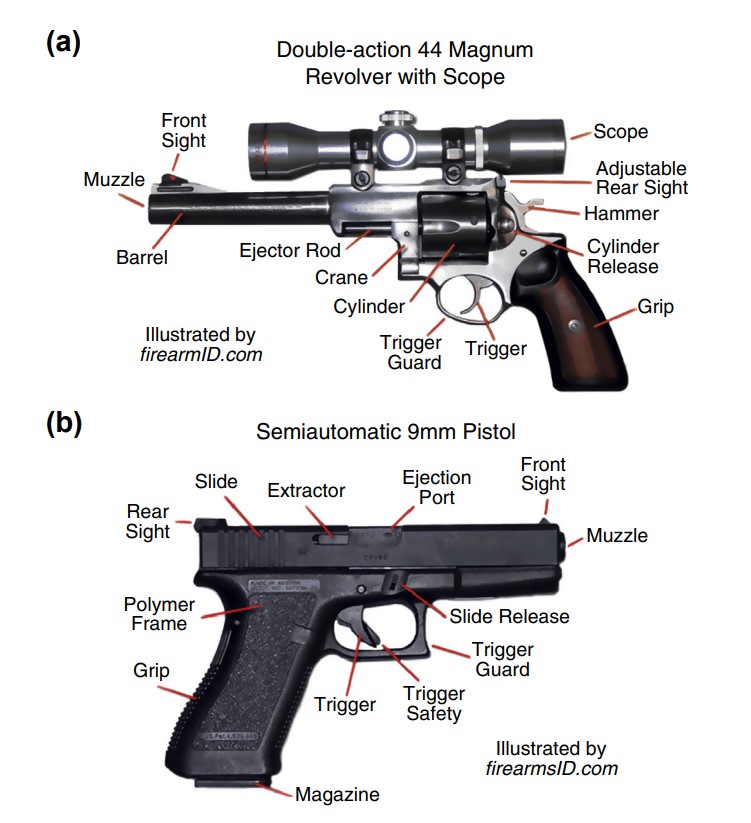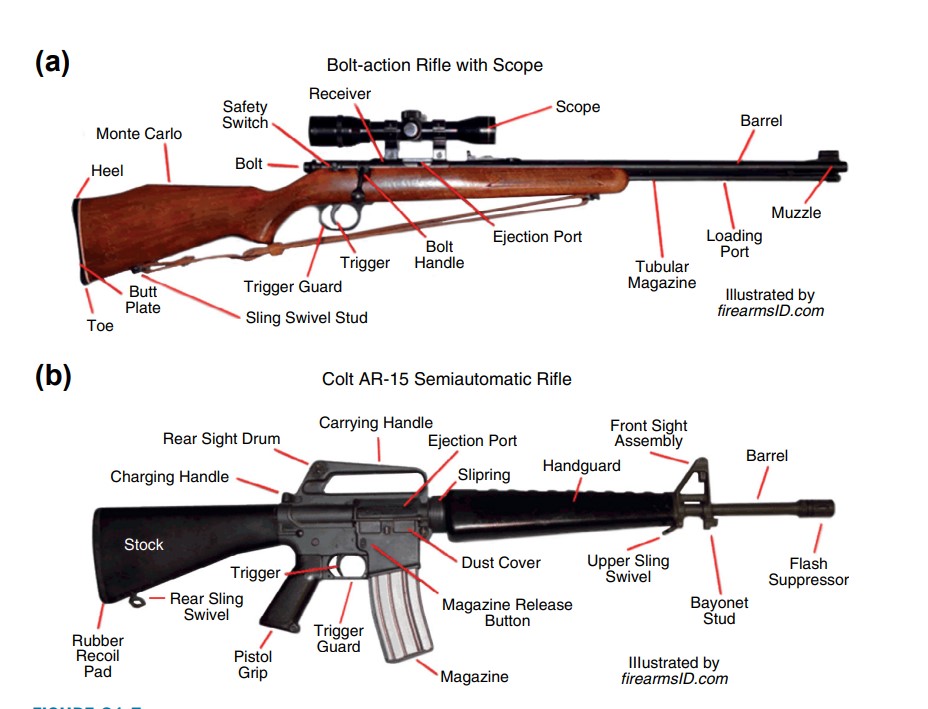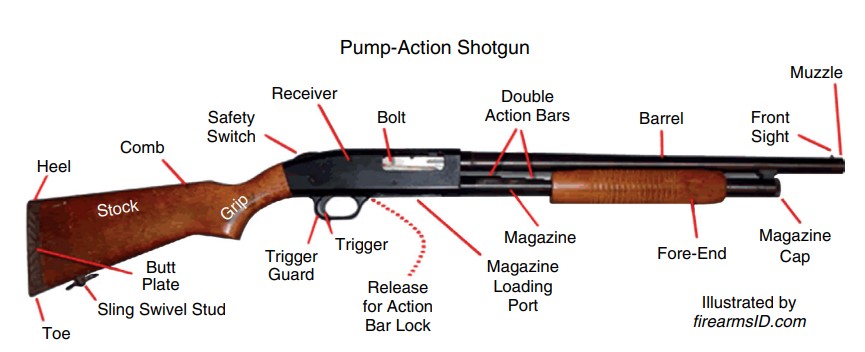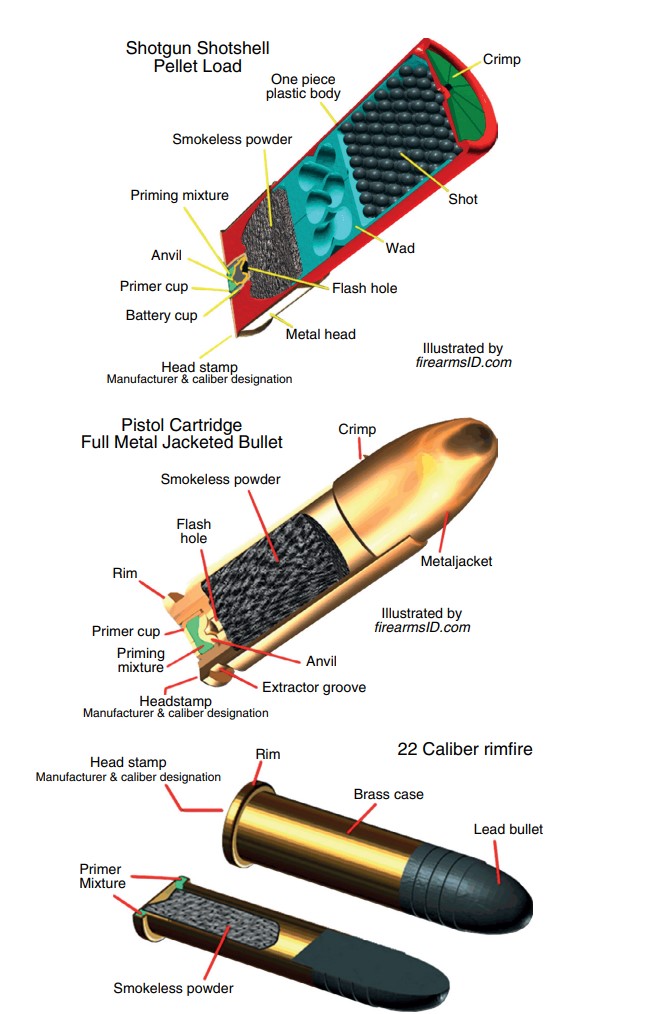
Chapter 21: Firearms and Tool Marks
21.1: Firearms
Ballistics –the study of an object in flight and is under the domain of physics.
Firearms examination – one of the key services a forensic science laboratory provides; even smaller laboratories with cooperation or direct harm, and society has judged this implied or actual violence to be a severe crime.
Disciplines of Forensic Firearms
Study of firearms, their manufacture, operations and performance;
The analysis of ammunition and its byproducts
The individualizing characteristics that are transferred from firearms to bullets and cartridges cases.
Types of Firearms
Handguns – designed to be fired with one hand.
Revolver – a handgun that feeds ammunition into the firing chamber by means of a revolving cylinder.
(Semi)Automatic Pistol – feeds ammunition by means of a spring-loaded vertical magazine.

Shoulder Firearms – more diverse, encompassing rifles, shotguns, machine guns, and submachine guns.
Rifles – designed to be fired from the shoulder with two hands; it may be single-shot, repeating, semi-automatic, or automatic.
Single-shot rifle – must be loaded, fired, the cartridge extracted, and then reloaded.
Repeating rifles fire – one bullet with each pull of the trigger, but the expended cartridge must be expelled, the firing mechanism cocked, and a live round reloaded from a magazine manually.
Semiautomatic rifles – use the energy of the fired ammunition to expel the empty cartridge, cock the firing mechanism, and reload a live round; thus, one pull of the trigger fires one round, and this may be done sequentially until the magazine is empty.
Assault rifles – can be fired either like semi-automatic rifles or in automatic mode: Pull the trigger, and the firearm will fire ammunition continuously until all the ammunition is gone.
Machine gun – a fully automatic firearm and therefore is fed ammunition from a high-capacity belt or box. Because of their size and the strength of the recoil, machine guns are meant to be fired from a tripod or other mounted/fixed position.
Submachine gun – a machine gun meant to be fired while held in the hands.

Firearm Barrels
Lands and Grooves – a series of ridges and valleys rifled in the interior surface of the barrels of the firearms.
Striations – microscopic contour variations on the surface of the bullet.
Broach or Rifling Button – a stiff metal rod with a flanged tip, which is run down the length of the hole.
Bore diameter – diameter of a circle that touches the tops of the lands.
Caliber – refers mostly to the size of a particular ammunition cartridge.
Pellets – numerous projectiles a shotgun fires.
Slugs – single projectiles.
A single-barrel shotgun can be either:
Single-shot: Manually loaded.
Repeating-shot: It has a spring-loaded auto-feeder or manual pump feeder with a reservoir of three to five shells.
Choke – helps to keep the pellets grouped longer once they leave the barrel.
Gauge – diameter of the shotgun barrel.

21.2: Anatomy of Ammunition
Ammunition – what a firearm fires; it is typically a self-contained cartridge that is composed of one or more projectiles, a propellant (to act as fuel), and a primer (to ignite the propellant).
As with firearms, ammunition comes in two major types: cartridges, for handguns and rifles and shells, for shotguns.
Bullet – the first type of projectile.
Lead bullets – pieces of lead hardened with minute amounts of other metals and formed into the desired shape.
Fully jacketed cartridge – a lead core that is encased in harder material, usually copper–nickel alloys or steel.
Semi-jacketed cartridge – has a metal jacket that covers only a portion of the bullet, with the nose often exposed.
Hollow-point cartridges – a semi-jacketed bullet that has a hollowed-out tip to increase this effect.
Propellant – the fuel that propels the projectile down and out of the firearm’s barrel.
Black Powder – the first propellant to be used in firearms.
Smokeless Powder – composed of nitrocellulose combined with various chemicals to stabilize the mix and modify it for safe manufacture and transport.
Primer – what ignites the propellant. It consists of a small metal cup containing a percussion-sensitive material that, when struck, creates enough heat to ignite the propellant.
Modern Primer materials consist of lead styphnate, antimony sulfide, barium nitrate, and tetracaine.

What happens when ammunition is discharged?
When the hammer strikes the primer cap on a live round chambered in a weapon, the primer explodes and ignites the propellant.
The burning of the propellant generates hot gases, which expand and push the bullet from its cartridge case and down the barrel.
The friction between the bullet and the rifling also transfers the pattern of lands and grooves to the bullet’s exterior.
Firing Pin Impression – the mark made by the firing pin as it strikes the printer cap.
Firearms that expel the spent cartridge may produce extraction marks and ejection marks from the chamber — breech marks are also left on the case.
Recoil – causes the cartridge base to smack against the breech face and receive an impression of any imperfections in the breech face.
As the bullet leaves the muzzle of the barrel, it is followed by a plume of the hot gases that forced it down the barrel.
As these materials strike, or come to rest on, a surface, they transfer potential evidence of that surface’s distance from the firearm’s muzzle and other materials that may indicate that surface’s association with the firing of a firearm or one that has been fired.
21.3: Collection of Firearms Analysis
Firearm Analysis
Safety and Operations Testing
A firearm should not be transferred or stored as evidence with a live round in the chamber unless there is an important reason to do so.
Information that is important to note in a preliminary firearms examination is the manufacturer, caliber, type of firearm, model, ammunition capacity, barrel length, and serial number.
Determine whether the firearm in question operates properly.
Bullet Comparisons
Comparison stereomicroscope – used in performing bullet comparisons.
Firearm Databases and Automated Search Systems
National Integration Ballistic Information Network (NIBIN) – automates ballistics evaluations and provides investigative leads by revealing connections between crimes in which the same firearm is used.
Tool Mark Comparisons
It is important for the tool mark examiner to have foundational knowledge about how various tools are made and machined.
The forensic tool mark examiner must pay close attention to the potential orientations of the questioned tool; otherwise, the test marks may not be comparable with the questioned marks.
Distance of Firing Determination
Gunpowder Residues – violent chemical reaction of the primer and accelerant results in a cloud of molten metals, partially burned gunpowder flakes, smoke, and other microscopic debris.
Bullet wipe – the residue of lead, primer materials, carbon, and other materials from the barrel that are transferred onto the outermost surface of the target by the bullet as it passes through.
Sodium Rhodizonate – the last chemical treatment used to visualize GSR.
Shotgun Distance Determination
As the pellets leave the shotgun barrel, they begin to spread based on the distance they travel and the choke of the barrel. Their pattern of spreading is indicative of the distance between the end of the barrel and the target.
Primer Residues – mostly microscopic blobs of molten metals.
Chapter 21: Firearms and Tool Marks
21.1: Firearms
Ballistics –the study of an object in flight and is under the domain of physics.
Firearms examination – one of the key services a forensic science laboratory provides; even smaller laboratories with cooperation or direct harm, and society has judged this implied or actual violence to be a severe crime.
Disciplines of Forensic Firearms
Study of firearms, their manufacture, operations and performance;
The analysis of ammunition and its byproducts
The individualizing characteristics that are transferred from firearms to bullets and cartridges cases.
Types of Firearms
Handguns – designed to be fired with one hand.
Revolver – a handgun that feeds ammunition into the firing chamber by means of a revolving cylinder.
(Semi)Automatic Pistol – feeds ammunition by means of a spring-loaded vertical magazine.

Shoulder Firearms – more diverse, encompassing rifles, shotguns, machine guns, and submachine guns.
Rifles – designed to be fired from the shoulder with two hands; it may be single-shot, repeating, semi-automatic, or automatic.
Single-shot rifle – must be loaded, fired, the cartridge extracted, and then reloaded.
Repeating rifles fire – one bullet with each pull of the trigger, but the expended cartridge must be expelled, the firing mechanism cocked, and a live round reloaded from a magazine manually.
Semiautomatic rifles – use the energy of the fired ammunition to expel the empty cartridge, cock the firing mechanism, and reload a live round; thus, one pull of the trigger fires one round, and this may be done sequentially until the magazine is empty.
Assault rifles – can be fired either like semi-automatic rifles or in automatic mode: Pull the trigger, and the firearm will fire ammunition continuously until all the ammunition is gone.
Machine gun – a fully automatic firearm and therefore is fed ammunition from a high-capacity belt or box. Because of their size and the strength of the recoil, machine guns are meant to be fired from a tripod or other mounted/fixed position.
Submachine gun – a machine gun meant to be fired while held in the hands.

Firearm Barrels
Lands and Grooves – a series of ridges and valleys rifled in the interior surface of the barrels of the firearms.
Striations – microscopic contour variations on the surface of the bullet.
Broach or Rifling Button – a stiff metal rod with a flanged tip, which is run down the length of the hole.
Bore diameter – diameter of a circle that touches the tops of the lands.
Caliber – refers mostly to the size of a particular ammunition cartridge.
Pellets – numerous projectiles a shotgun fires.
Slugs – single projectiles.
A single-barrel shotgun can be either:
Single-shot: Manually loaded.
Repeating-shot: It has a spring-loaded auto-feeder or manual pump feeder with a reservoir of three to five shells.
Choke – helps to keep the pellets grouped longer once they leave the barrel.
Gauge – diameter of the shotgun barrel.

21.2: Anatomy of Ammunition
Ammunition – what a firearm fires; it is typically a self-contained cartridge that is composed of one or more projectiles, a propellant (to act as fuel), and a primer (to ignite the propellant).
As with firearms, ammunition comes in two major types: cartridges, for handguns and rifles and shells, for shotguns.
Bullet – the first type of projectile.
Lead bullets – pieces of lead hardened with minute amounts of other metals and formed into the desired shape.
Fully jacketed cartridge – a lead core that is encased in harder material, usually copper–nickel alloys or steel.
Semi-jacketed cartridge – has a metal jacket that covers only a portion of the bullet, with the nose often exposed.
Hollow-point cartridges – a semi-jacketed bullet that has a hollowed-out tip to increase this effect.
Propellant – the fuel that propels the projectile down and out of the firearm’s barrel.
Black Powder – the first propellant to be used in firearms.
Smokeless Powder – composed of nitrocellulose combined with various chemicals to stabilize the mix and modify it for safe manufacture and transport.
Primer – what ignites the propellant. It consists of a small metal cup containing a percussion-sensitive material that, when struck, creates enough heat to ignite the propellant.
Modern Primer materials consist of lead styphnate, antimony sulfide, barium nitrate, and tetracaine.

What happens when ammunition is discharged?
When the hammer strikes the primer cap on a live round chambered in a weapon, the primer explodes and ignites the propellant.
The burning of the propellant generates hot gases, which expand and push the bullet from its cartridge case and down the barrel.
The friction between the bullet and the rifling also transfers the pattern of lands and grooves to the bullet’s exterior.
Firing Pin Impression – the mark made by the firing pin as it strikes the printer cap.
Firearms that expel the spent cartridge may produce extraction marks and ejection marks from the chamber — breech marks are also left on the case.
Recoil – causes the cartridge base to smack against the breech face and receive an impression of any imperfections in the breech face.
As the bullet leaves the muzzle of the barrel, it is followed by a plume of the hot gases that forced it down the barrel.
As these materials strike, or come to rest on, a surface, they transfer potential evidence of that surface’s distance from the firearm’s muzzle and other materials that may indicate that surface’s association with the firing of a firearm or one that has been fired.
21.3: Collection of Firearms Analysis
Firearm Analysis
Safety and Operations Testing
A firearm should not be transferred or stored as evidence with a live round in the chamber unless there is an important reason to do so.
Information that is important to note in a preliminary firearms examination is the manufacturer, caliber, type of firearm, model, ammunition capacity, barrel length, and serial number.
Determine whether the firearm in question operates properly.
Bullet Comparisons
Comparison stereomicroscope – used in performing bullet comparisons.
Firearm Databases and Automated Search Systems
National Integration Ballistic Information Network (NIBIN) – automates ballistics evaluations and provides investigative leads by revealing connections between crimes in which the same firearm is used.
Tool Mark Comparisons
It is important for the tool mark examiner to have foundational knowledge about how various tools are made and machined.
The forensic tool mark examiner must pay close attention to the potential orientations of the questioned tool; otherwise, the test marks may not be comparable with the questioned marks.
Distance of Firing Determination
Gunpowder Residues – violent chemical reaction of the primer and accelerant results in a cloud of molten metals, partially burned gunpowder flakes, smoke, and other microscopic debris.
Bullet wipe – the residue of lead, primer materials, carbon, and other materials from the barrel that are transferred onto the outermost surface of the target by the bullet as it passes through.
Sodium Rhodizonate – the last chemical treatment used to visualize GSR.
Shotgun Distance Determination
As the pellets leave the shotgun barrel, they begin to spread based on the distance they travel and the choke of the barrel. Their pattern of spreading is indicative of the distance between the end of the barrel and the target.
Primer Residues – mostly microscopic blobs of molten metals.
 Knowt
Knowt
